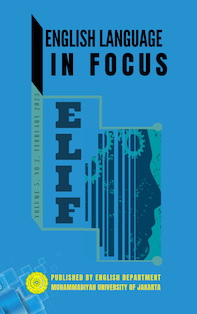Further Knowledge for Teachers and Children Practice English More: Teaching English for Young Learners
DOI:
https://doi.org/10.24853/elif.5.2.171-178Keywords:
Knowledge, Young Learners, Teachers, Practice, effectivelyAbstract
It is commonly recognized by informed teachers and educators that the discipline of children's English practice gains from a synthesis of applied linguistics, education psychology, and pedagogical perspectives. Young English language learners differ from adult English language learners in several learning practice. This would necessitate teacher consideration, on how to instruct students appropriately and effectively in the classroom. Studying English shouldn't be a stressful experience for children. At the age of the children category is the initial age to determine whether or not to like and dislike English. Teacher must provide teaching English with enjoyable. Therefore, activities of reading, listening, and speaking of English should become natural and easy for students as a result of their studies. Therefore, students can develop English with fun. This paper investigates some overviews of teaching English to young learners, such as; the importance of understanding among some student’s differences ages category, means of young learner, young learner’s characteristics, method of teaching young learner, and advantages and disadvantages in implementing TPR method. This study outlines several resources for EFL teachers to help children in learning a foreign language.References
Anh, N. T. C., & Ho, P. V. P. (2018). THE EFFECT OF USING TOTAL PHYSICAL RESPONSE (TPR) ON EFL YOUNG LEARNERS’ VOCABULARY AND SPEAKING FLUENCY. International Journal Of Tesol Education, 128–137.
Asher, J. J. (1969). The Total Physical Response Approach to Second Language Learning. The Modern Language Journal, 53(1), 3–17.
Cameron, Lynne. (2001). Teaching languages to young learners. Cambridge University Press.
Chasanah, R. (2014). TOTAL PHYSICAL RESPONSE (TPR) UNTUK MENINGKATKAN TEKNIK MAHARAH AL-KALAM PADA SISWA MADRASAH IBTIDAIYAH. MADRASAH Jurnal Pendidikan Dan Pembelajaran Dasar, 7(1), 27–52.
Harmer, J. (2005). The Practice of English Language Teaching (Vol. 3).
Harmer, J. (2007). The Practice of English Language Teaching. Pearson Longman: Cambirdge.
Hartina, S., Salija, K., & Amin, F. H. (2019). Teachers’ Techniques in Teaching English to Young Learners at TK Bambini School of Makassar. In Indonesian Tesol Journal (Vol. 1, Issue 1). Online.
Kastuhandani, F. C. (2014). Technology and Young Learners. LLT Journal, 17(1), 1–8.
Krashen, D. S., & Terrell, D. T. (1995). The Natural Approach: Language Acquisition in the Classroom (Vol. 2). Essex: Pearson Education Limited.
McKay, P. (2006). Assessing young learners A toolkit for teacher development. United Kingdom: Cambridge University Press.
Nicoleta Padurean, A., & Vlaicu, A. (2014). Teaching English Language to Children with Special Educational Needs. TEM Journal, 3(4), 309–314. www.temjournal.com
Nigora, U. (2018). USING TOTAL PHYSICAL RESPONSE IN PRIMARY SCHOOL CLASSES. European Journal of Research and Reflection in Educational Sciences, 6(1). www.idpublications.org
Nikoopour, J., & Farsani, M. A. (2011). English Language Teaching Material Development. Journal of Language and Translation , 2(2), 1–12. https://www.researchgate.net/publication/344270454
Ningsih, P. E. A., & Ningsih, E. A. (2020). THE USE OF FREEZE FRAMING TECHNIQUE FOR TEACHING ENGLISH TO YOUNG LEARNERS AT TOWN FOR KIDS PRESCHOOL JAMBI. Jurnal Inovasi Penelitian, 1(7), 1413–1426.
Nuraeni, C. (2019). Using Total Physical Response (TPR) Method on Young Learners English Language Teaching. METATHESIS: JOURNAL OF ENGLISH LANGUAGE LITERATURE AND TEACHING, 3(1), 26–34. https://doi.org/10.31002/metathesis
Octaviana, D. W. (2017). TEACHING ENGLISH TO YOUNG LEARNERS. Journal of English Teaching and Research, 2(2), 124–133.
Pahri, *, Tinggi, S., Islam, A., Al-Ayyubi, S., & Jakarta, I. (2021). Implementation of Total Physical Response (TPR) Method in Improving Arabic Speaking Skills. Tanwir Arabiyyah: Arabic as Foreign Language Journal, 1(2), 63–72. https://doi.org/10.31869/afl.v1i2.2872
Richards, C. J., & Rodgers, S. T. (2001). Approaches and methods in language teaching (2nd ed) (Vol. 2). Cambridge University Press.
Scott, W., & Lisbeth, Y. (1992). Teaching English to Children. London: Longman.
Septy Lesia, E., & Petrus, I. (2021). Teaching English for Young Learners in Elementary School: Perceptions and Strategies. International Journal of Elementary Education, 6(1), 142–148. https://doi.org/10.23887/ijee.v6i1
Shi, T. (2018). A Study of the TPR Method in the Teaching of English to Primary School Students. Theory and Practice in Language Studies, 8(8), 1087. https://doi.org/10.17507/tpls.0808.25
Siswanto, A. (2017). The 2 nd TEYLIN International Conference Proceedings TEACHING ENGLISH TO YOUNG LEANERS: A REFLECTION FORM ENGLAOSHI COMMUNITY (2nd ed.). English Education Department.
Stern, H. H. (1983). Fundamental Concepts of Language Teaching.
Sukarno. (2008). TEACHING ENGLISH TO YOUNG LEARNERS AND FACTORS TO CONSIDER IN DESIGNING THE MATERIALS. Jurnal Ekonomi Dan Pendidikan, 5(1), 57–73.
Wadsworth, J. B. (1971). Piaget’s theory of cognitive development: An introduction for students of psychology and education. McKay.
Wahidah Pido, N., & Dewi, E. (2019). ENGLISH TEACHING METHOD APPLIED BY TEACHERS IN MTs NEGERI MODEL LIMBOTO. AL-Lisan Journal Bahasa Dan Pengajaran, 4(1), 57–70. http://journal.iaingorontalo.ac.id/index.php/al
Widodo, H. P. (2005). Teaching Children Using a Total Physical Response (TPR) Method: Rethinking. Bahasa Dan Seni, 33(2), 235–248
Published
Issue
Section
License
Authors who publish with this journal agree to the following terms:
- Authors retain copyright and grant the journal right of first publication with the work simultaneously licensed under a Creative Commons Attribution License that allows others to share the work with an acknowledgment of the work's authorship and initial publication in this journal.
- Authors can enter into separate, additional contractual arrangements for the non-exclusive distribution of the journal's published version of the work (e.g., post it to an institutional repository or publish it in a book), with an acknowledgment of its initial publication in this journal.
- Authors are permitted and encouraged to post their work online (e.g., in institutional repositories or on their website) before and during the submission process, as it can lead to productive exchanges, as well as earlier and greater citation of published work (See The Effect of Open Access).


